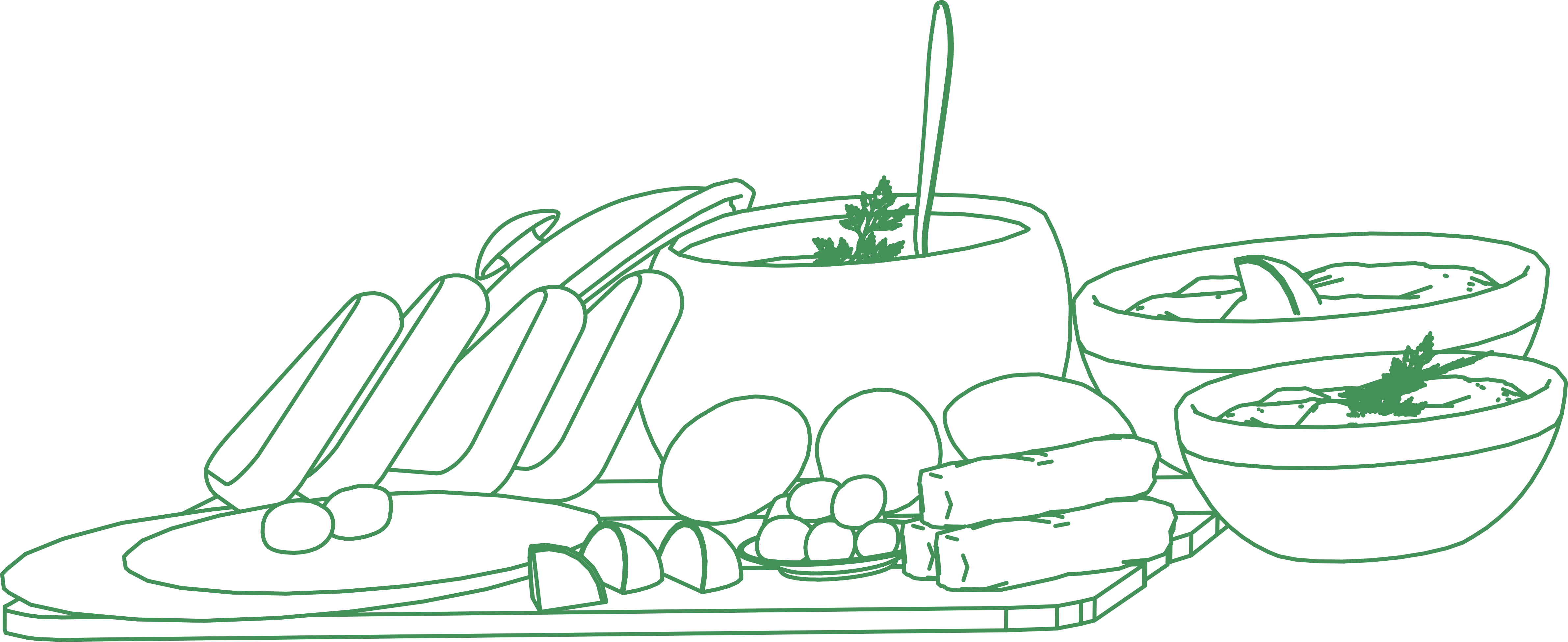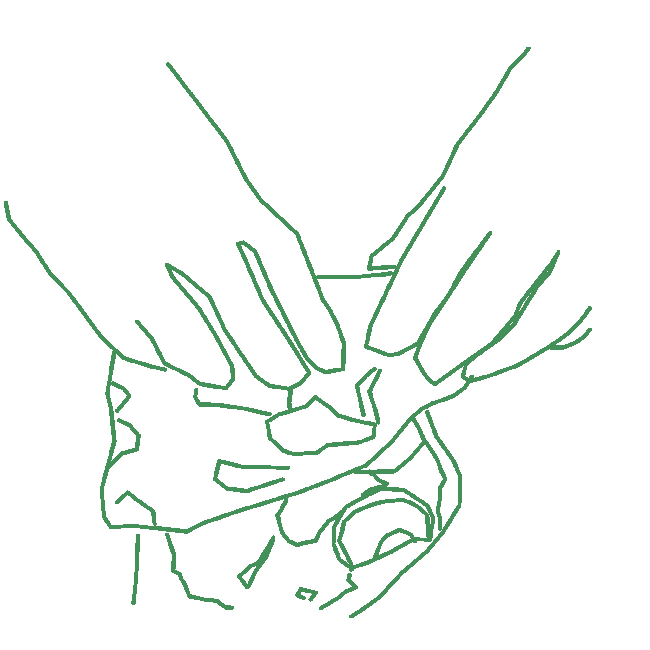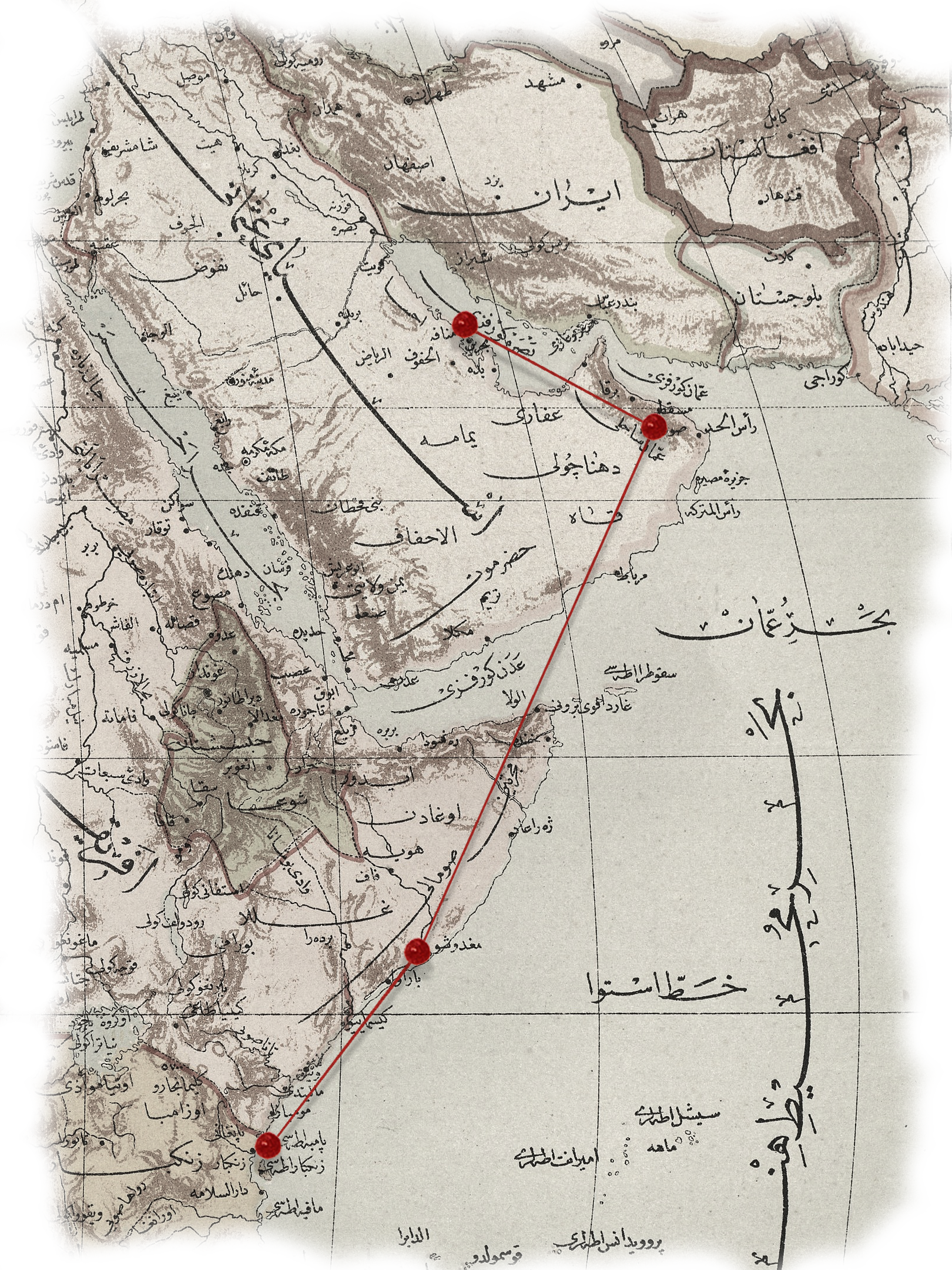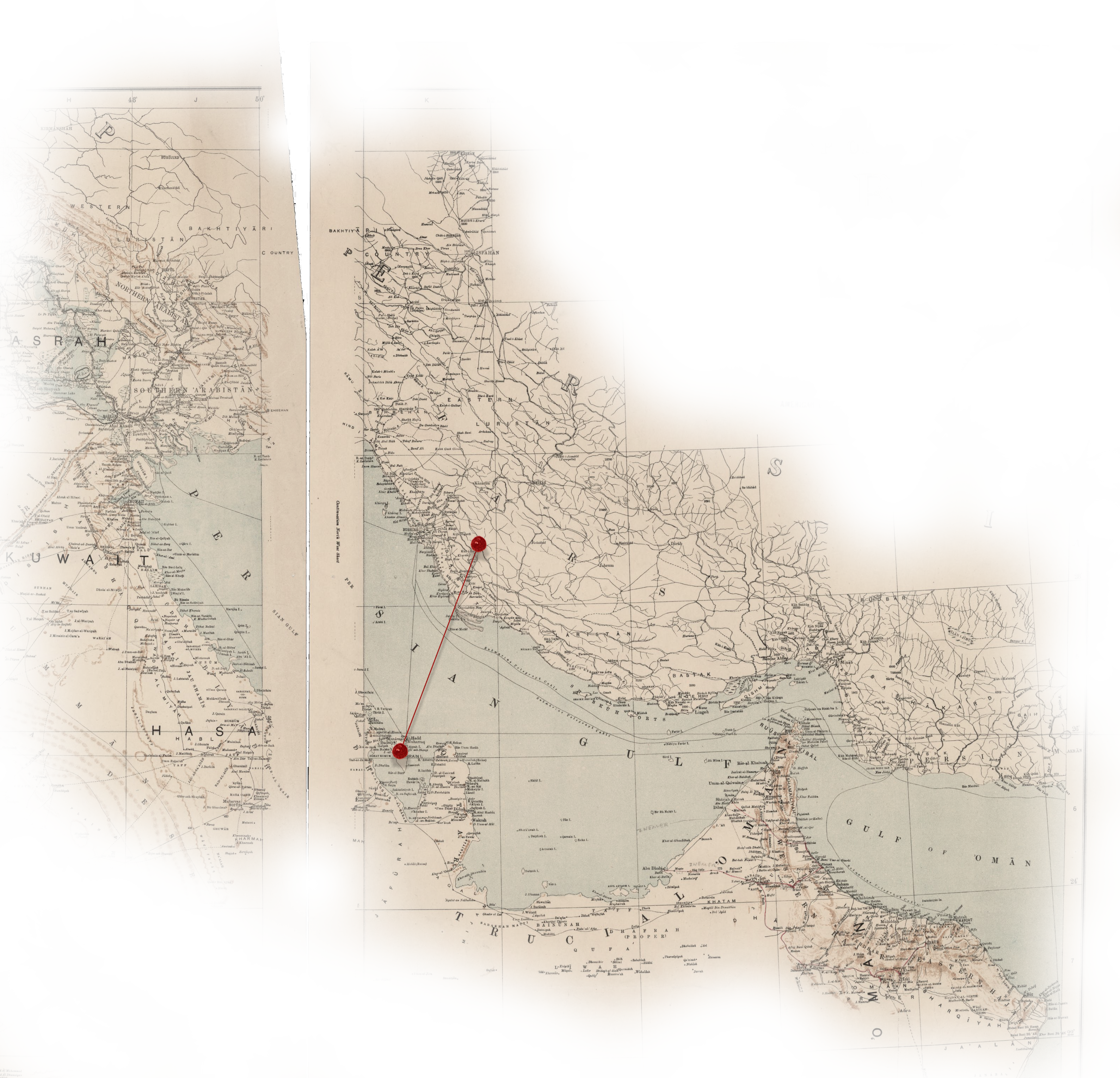
Kanwal Hameed
Halwa, Mahyawa and Multiple Registers of Life in the Gulf





Step 1

Step 2




Step 3






Step 4

This work emerged from a
conversation with a Somali friend who commented on the box of halwa I
had brought from Bahrain, noting that it looked very similar to Somali xalwo from Mogadishu. Broadly speaking, there are two well-known and popular halwa variants in the Gulf – halwa Omaniyya (Omani halwa) and halwa Bahrainiyya (Bahraini halwa). I was curious about a connection to East Africa that my
friend’s comment intimated. Here, through two food items - mahyawa (a
condiment of dried fish and spices preserved in oil) and halwa Bahrainiyya (a traditional sweet flavoured with saffron and rose water and decorated with
nuts) - I discuss the sea as an archive.
[i] Ann
Laura Stoler, Along the Archival Grain: Epistemic Anxieties and Colonial
Common Sense, Princeton (Princeton University Press: 2009).
I think about networks connecting the
islands of Bahrain with the southern coast of modern-day Iran and the eastern
coast of Africa. I propose an archival practice that reads the archive with
life, outside of the looming building, the securitised access, the search
through catalogue numbers and missing pages, the solemn (and often uncomfortable
or angering)
process of sifting through the registers of imperial bureaucracy. From Laura
Ann Stoler’s suggestion[i] – to see
the messy, scribbled, drafted and re-drafted letters and annotated
conversations in the margins of Official Archives – I argue that official
archives too are a form of politically situated vernacular. Drawing on a rich
black feminist radical tradition, I propose that outside of these archives
there are multitudes- which can intuit and invite knowledge production and ways
of knowing that have not been contained by the repositories of the Archive
proper. They compel us towards what Saidiya Hartman describes as, ‘… scraps of the archive … unknown persons, nameless
figures, ensembles, collectives, multitudes, the chorus. That’s where my
imagination of practice resides. That’s where my heart resides.’. I am
conscious that for Saidiya, this practice is a way of redress for the,
‘monumental crime that was the transatlantic slave trade’. Here I extend her
thinking to do something different, also with both material and immaterial
resources, in the face of other forms of ignorance and erasure.
The archival practice that went into writing this article was marked by these overlapping processes -
Intimation: the introduction to an idea, concept or question. In this case, the discussion about Somali xalwo and Bahraini halwa, grounded in everyday life, which aroused my own political and academic curiosity about connections between Bahrain/ the Gulf, and other locations. Halwa/Xalwo, in Bahrain, Oman and Somalia is a mixture of white and brown sugars caramelised in a large metal pot, forming the base. Fat – ghee or vegetable oil - water, starch, and fragrant spices, nuts, seeds and colouring are added to it throughout the cooking process, which takes approximately three hours. Spices, seeds, nuts and colourings can include nutmeg, cardamom, saffron or food colouring and cashews, pistachios or sesame seeds. The ingredients vary depending on the type of halwa, and where it is being made. Before serving, the halwa is decorated with nuts or seeds. The final product is rich, has a silky jelly-like and sticky texture, and is often enjoyed in spoonful servings at celebrations with gahwa ‘Arabiyya, yellow Arabic coffee. A Bahrain variation involves eating it with khobz tannur, a light flatbread, instead of a spoon – and the Internet has shown me xalwo being eaten between a sandwich of biscuits …
The archival practice that went into writing this article was marked by these overlapping processes -
Intimation: the introduction to an idea, concept or question. In this case, the discussion about Somali xalwo and Bahraini halwa, grounded in everyday life, which aroused my own political and academic curiosity about connections between Bahrain/ the Gulf, and other locations. Halwa/Xalwo, in Bahrain, Oman and Somalia is a mixture of white and brown sugars caramelised in a large metal pot, forming the base. Fat – ghee or vegetable oil - water, starch, and fragrant spices, nuts, seeds and colouring are added to it throughout the cooking process, which takes approximately three hours. Spices, seeds, nuts and colourings can include nutmeg, cardamom, saffron or food colouring and cashews, pistachios or sesame seeds. The ingredients vary depending on the type of halwa, and where it is being made. Before serving, the halwa is decorated with nuts or seeds. The final product is rich, has a silky jelly-like and sticky texture, and is often enjoyed in spoonful servings at celebrations with gahwa ‘Arabiyya, yellow Arabic coffee. A Bahrain variation involves eating it with khobz tannur, a light flatbread, instead of a spoon – and the Internet has shown me xalwo being eaten between a sandwich of biscuits …




Video showing the serving
of halwa Bahrainiyya at a popular sweet shop in the Manama souq.
[ii] Awet Teklehimanot, The Red Sea/East Africa and the Gulf. An
Archaeological and Historical Investigation of the African Diaspora in Bahrain
during the Islamic Period (7th - 20th c. AD). Unpublished PhD Thesis, Institute of Arab and Islamic Studies (IAIS)
University of Exeter.
I read a newspaper interview with a member of one branch of Bahrain’s most
famous halwa making family, who claimed that one and a half centuries
ago, his grandfather (Abdullah Ibrahim Showaiter) ended up in Zanzibar as a
diver, and learned how to make halwa from people there, before returning
to Bahrain and beginning his own halwa venture. I received a message from
the same friend: ‘I also found out that they have similar xalwa in Oman
– which makes sense too – they have [a] huge Zanzibar and Somali community
there. Maybe there is a link with Omani and Bahraini xalwa!?!’. Archaeological
findings in Bahrain, Iraq, and the UAE indicate that seaborne connections with
East Africa date at least to the fifteenth century, and recent findings in the
UAE suggest connections since the early Islamic era. Findings along the
southern Red Sea also trace a route linking Eritirea and Ethiopia to India and
Sri Lanka ‘transiting through ports in the Gulf’[ii] during the pre-Islamic period.
I looked to a map of the Indian Ocean to think about contact between peoples.
I looked to a map of the Indian Ocean to think about contact between peoples.

Mapping Currents: in this phase, I developed
upon the initial ideas through further research and triangulation through
multiple academic and popular/ non-academic secondary sources. I watched videos
about halwa/xalwo, read recipes, looked up maps, read about Indian Ocean
worlds, the Omani empire, and the slave trade in the Gulf. I looked to the
local press newspaper for articles about halwa Bahrainiyya, and came across an interview with
a member of a different branch of the sweet maker family - who claims that his grandfather (Hussein
Muhammad Shwaiter) spent three months in Najaf, Iraq, learning to make what is
now Bahrain’s famous halwa, which he began selling from his home in
1850. I researched links between Najaf and Oman – which I found were linked by
steamship.
Food, through its political, socio-economic, raced, classed, gendered and affective connection with land, is undoubtedly an archive. Vivien Sansour’s Palestine Heirloom Seed Library is a vibrant and critical political project which encapsulates one element of food as archive. Food is also, however, a vector for politics of belonging and difference, connection and longing for diasporic communities, and history and memory – as told in the beautiful and complex reading of Iranian cookbooks by Laleh Khalili. Vivien Sansour’s project compels us towards thinking about food as archive – work that is being carried out in different forms in Bahrain, for example by anthropologist Dalal Al Sheroogi. I however, was compelled by the article by Laleh Khalili to think instead with the sea as an archive, and to ask what connections are carried through the food I was exploring. I wanted to think about questions of history, human circulation and exchange (in their varied and unequal intimations) that arose from the food in question. I was careful while working on this piece to avoid contributing to a tendency in popular and academic works on the Middle East towards fetishizing the ordinary. I wanted to use the food item as an entry point to ask what it might tell us about politics, history, culture, memory and identity, human relations with each other and with the natural environment (the sea).
Food, through its political, socio-economic, raced, classed, gendered and affective connection with land, is undoubtedly an archive. Vivien Sansour’s Palestine Heirloom Seed Library is a vibrant and critical political project which encapsulates one element of food as archive. Food is also, however, a vector for politics of belonging and difference, connection and longing for diasporic communities, and history and memory – as told in the beautiful and complex reading of Iranian cookbooks by Laleh Khalili. Vivien Sansour’s project compels us towards thinking about food as archive – work that is being carried out in different forms in Bahrain, for example by anthropologist Dalal Al Sheroogi. I however, was compelled by the article by Laleh Khalili to think instead with the sea as an archive, and to ask what connections are carried through the food I was exploring. I wanted to think about questions of history, human circulation and exchange (in their varied and unequal intimations) that arose from the food in question. I was careful while working on this piece to avoid contributing to a tendency in popular and academic works on the Middle East towards fetishizing the ordinary. I wanted to use the food item as an entry point to ask what it might tell us about politics, history, culture, memory and identity, human relations with each other and with the natural environment (the sea).

Social media sensation, Muhamed Badeea Kamal @m_bu_badee3” makes a mahyawa sandwich using local bread that he describes as “khobz holi”, referring to the Huwala (see below) who are widely thought to have introduced this bread-making tradition and mahyawa to Bahrain.
Watch Here
Choosing a route: Once I decided I wanted to engage with
sea-based connections, and the sea as a repository of knowledge and ways of
knowing each other, this choice both expanded and shaped my research. I started
to think about another unique local dish, mahyawa, its preparation process
and history, in order to build some sense of the connections it suggested. I
ate mahyawa with a childhood friend, whose aunt offered it to me with a type of
flatbread called falazin, which we ate rolled up. Her aunt described the
long process preparing mahyawa – the cleaning and drying of small fish known asmattoot – and preserving them in oil with spices over a period of
several months.
[iii] Fahad Bishara, (2016). “Ships Passing in the
Night? Reflections on the Middle East in the Indian Ocean.” International
Journal of Middle East Studies. 48. 758-762.
The
Gulf has long been portrayed as an isolated backwater of modernity world,
propelled from its primitive state into the dynamic global through the European
and American discovery and subsequent exploitation of oil. I knew I was
interested in understanding Bahrain and the Gulf as a place that connected with
and was part of multiple worlds. And so, I identified that for this piece I
would think about the connections between Bahrain the northern coast of the
Gulf, and the eastern coast of Africa. I turned to the work of Fahad Bishara,
who writes and shows in his work (along with others): ‘the potential that the
Indian arena offered for breaking out of the stale narratives and stagnant and
stagnant historiographies that characterized the study of the Gulf and South
Arabia’.[iii]
Once I decided to explore the sea as an archive, mapping connections that produced and reflected multiple registers of life in the Gulf, I expanded my repertoire to bring in another food item – mahyawa. This condiment is widely thought to have arrived to Bahrain with Arab migrants originally from the peninsula, who settled along the Southern coast of modern-day Iran before migrating again to the known locally as Huwala. I was told by a friend that the word mahyawa comes from the Southern Iranian dialect word which is combination of ‘ma’ (fish) and ‘oh’ (water), and another friend’s mother offered the pronunciation - ‘ma-wah’ - as the root of the word mahyawa in local Arabic.
Once I decided to explore the sea as an archive, mapping connections that produced and reflected multiple registers of life in the Gulf, I expanded my repertoire to bring in another food item – mahyawa. This condiment is widely thought to have arrived to Bahrain with Arab migrants originally from the peninsula, who settled along the Southern coast of modern-day Iran before migrating again to the known locally as Huwala. I was told by a friend that the word mahyawa comes from the Southern Iranian dialect word which is combination of ‘ma’ (fish) and ‘oh’ (water), and another friend’s mother offered the pronunciation - ‘ma-wah’ - as the root of the word mahyawa in local Arabic.

[iv] 'Gazetteer of the Persian Gulf. Vol. II.
Geographical and Statistical. J G Lorimer. 1908' [1160] (1253/2084), British Library: India Office Records and
Private Papers, IOR/L/PS/20/C91/4, in Qatar Digital Library
<https://www.qdl.qa/archive/81055/vdc_100023515717.0x000037> [accessed 24
November 2022]
[v] 'Gazetteer of the Persian Gulf. Vol. II. Geographical and Statistical. J G Lorimer. 1908' [238] (265/2084), British Library: India Office Records and Private Papers, IOR/L/PS/20/C91/4, in Qatar Digital Library <https://www.qdl.qa/archive/81055/vdc_100023515712.0x000042> [accessed 24 November 2022]
[v] 'Gazetteer of the Persian Gulf. Vol. II. Geographical and Statistical. J G Lorimer. 1908' [238] (265/2084), British Library: India Office Records and Private Papers, IOR/L/PS/20/C91/4, in Qatar Digital Library <https://www.qdl.qa/archive/81055/vdc_100023515712.0x000042> [accessed 24 November 2022]
I went back to a map of the
Gulf. As my markings show, mahyawa, connects the islands of Bahrain (as
well as Kuwait, Qatar and the UAE) across the sea, to Southern Iran. According
to my friend’s mother, it connects specifically with Fars, where many
Bahraini families trace familial lineage. Her comment points to the regional diversity
of Iranian food, which is borne out by the country’s geographic and topographic
disparity – and my own discussions with friends from Northern Iran that had
never heard of mahyawa. The Huwala are recorded in Lorimer’s
Gazetteer of the Persian Gulf as making up just over 10 per cent of the
residents of Manama in 1908[iv],
and as the ‘most numerous community of Sunnis’[v]living in both principal cities of Bahrain at the time, Manama and Muharraq.
Immersion: I then went on to explore both elements. This included thinking about how both the foods – as products of historical processes of circulation, exchange, dominance – are part of everyday life today. This is usually the phase of ‘collecting’ archival resources, and engaging in further secondary reading. To this I added elements of the quotidian: eating, visiting the souq (market) where halwaand mahyawa are sold. I made two visits to a popular halwa shop in the Manama souq and observed the selling of halwa to queues of customers, including locals as well as visitors from Oman and Hasa, Saudi Arabia. I thought about the re-circulation of the foods – as products – and about the historic trade circulations that would have provided the ingredients which went into the making of halwa and mahyawa, and the ways in which these may have changed based on economic and political conditions.
Immersion: I then went on to explore both elements. This included thinking about how both the foods – as products of historical processes of circulation, exchange, dominance – are part of everyday life today. This is usually the phase of ‘collecting’ archival resources, and engaging in further secondary reading. To this I added elements of the quotidian: eating, visiting the souq (market) where halwaand mahyawa are sold. I made two visits to a popular halwa shop in the Manama souq and observed the selling of halwa to queues of customers, including locals as well as visitors from Oman and Hasa, Saudi Arabia. I thought about the re-circulation of the foods – as products – and about the historic trade circulations that would have provided the ingredients which went into the making of halwa and mahyawa, and the ways in which these may have changed based on economic and political conditions.

[vi] Donna
Honarpisheh. "The Sea as Archive: Impressions of Qui Se Souvient De La Mer." symploke, vol. 27 no.
1, 2019, p. 91-109. Project MUSE muse.jhu.edu/article/734653.
I read a beautiful meditation by Donna
Honarpisheh on The Sea As Archive… in the Algerian novel
Qui Se Souvient De La Mer (Mohammad Dib). I was especially struck by
the thought that:
With the presence of these absent traces, the sea as archive points to world events that slip away from the apparatuses of recordkeeping either because their essence defies conservational practices or because the state prohibits their keeping.[vi]
[vii] Omar H Al Shehabi, Contested Modernity,
Sectarianism, Nationalism and Colonialism in Bahrain. (Oxford, OneWorld
Publications: 2017).
[ix] Rosie Bsheer, Archive Wars: The Politics of History in Saudi Arabia (Stanford: Stanford University Press, September 2020).
[ix] Rosie Bsheer, Archive Wars: The Politics of History in Saudi Arabia (Stanford: Stanford University Press, September 2020).
It
encouraged me to ask what the sea as an archive could tell us about the way in
which people know themselves and each other – and how do these archives sit
within, or in contestation with, official records and representations? The
legalisation of who is known as local and foreign in Bahrain (as elsewhere) has
been a contested[vii] process,
structured largely by a British colonial administration acting with local
ruling powers. I am interested in the the world that recedes from both official
and external purview – even while it is present in the lived experiences of
people. In this world Oman, Zanzibar, Najaf, and Southern Iran are part of
Bahrain’s local history, linked across the seas, and seen here through their
connections through mahyawa and halwa. Tidying complex and
entangled pasts into a palatable and powerful National History[ix],
inevitably involves a selective approach to ‘world events’ – or in this case,
ongoing processes of circulation and migration of communities, traders,
labourers and enslaved divers that traverse the edges of nation and empire. I
think the sea as an archive, however, suggests that the essence of these worlds
might not defy conservational practices, rather they are conserved through
their continued practice and production in ordinary life.
Surface, review, broaden the horizon of
thought: this phase involved sorting through ideas and
findings, writing, reviewing, and raising new questions - always thinking about
power. Keeping the dynamics of power in sight helps to clarify the historian’s
romantic notions about ways in which we knew each other in the past. The story
of the sea as an archive of circulations of relationality and exchange in the
Gulf is also the story of imperialism and the sinews of
violent control over land and resources, the wretched history of slavery and colonialism, and the hardship, gruelling experience and exploitation of diving. It
raises questions about the dynamics - popular and authoritarian - that produce
today’s iterations of the ‘Arabian’ and ‘Persian’ Gulfs (without underplaying
the political contestations this infers, I do sometimes wonder, whether the sea
laughs at us as we chafe and tussle over its name).
This story invites further questions; for example, about changing relations with the sea in Bahrain through land reclamation and privatisation, and how the archive of the sea and the way it pushes past methodological nationalist has been re-shaped and framed within a glossy nationalnarrative. It asks us to push past methodological nationalism, but also to examine the socio-economic mesh of race, nationality, class, and gender shaping ideas and structures of belonging in the modern Gulf. It reminds us that these ideas have been forged, challenged and shaped intellectually, affectively and materially through the connections sought and torn by peoples across multiples scales of time.
In this piece I discuss archival practices to suggest that thinking about the archive asks us to think about epistemology: about knowledge and its production, and not just about sources. How do we move, work, and think differently when we are outside of the politically classified (and reified) Official Archives? What are the material and theoretical implications, expectations, and limits of working and thinking in this way? What changes, when we think about land in connection with water, what forms of mapping do we engage with, and what layers of understanding can this produce? Thinking about the sea as an archive is also thinking about the limits of knowing; sitting with the sense that we cannot fully know or capture something so vast, and the tug which pulled us is rendered incomplete as it is remade repetitively through the water in motion.
This story invites further questions; for example, about changing relations with the sea in Bahrain through land reclamation and privatisation, and how the archive of the sea and the way it pushes past methodological nationalist has been re-shaped and framed within a glossy nationalnarrative. It asks us to push past methodological nationalism, but also to examine the socio-economic mesh of race, nationality, class, and gender shaping ideas and structures of belonging in the modern Gulf. It reminds us that these ideas have been forged, challenged and shaped intellectually, affectively and materially through the connections sought and torn by peoples across multiples scales of time.
In this piece I discuss archival practices to suggest that thinking about the archive asks us to think about epistemology: about knowledge and its production, and not just about sources. How do we move, work, and think differently when we are outside of the politically classified (and reified) Official Archives? What are the material and theoretical implications, expectations, and limits of working and thinking in this way? What changes, when we think about land in connection with water, what forms of mapping do we engage with, and what layers of understanding can this produce? Thinking about the sea as an archive is also thinking about the limits of knowing; sitting with the sense that we cannot fully know or capture something so vast, and the tug which pulled us is rendered incomplete as it is remade repetitively through the water in motion.
[x] Rosie Bsheer, Archive Wars: The Politics of
History in Saudi Arabia (Stanford: Stanford University Press, September
2020).
All this is to suggest that the archive
lives. Like the histories it carries, it too has been claimed, catalogued,
contained, channelled across oceans. Against and through these processes, in
which it has been scattered like light mirrored on the surface of water - and
like water - it hides, it connects, heaves, and crashes onto distant shores. The
processes of dissemination or dispersal, as the process of knowledge production,
are always inflected with dynamics of power. The living archive is, and
contains the multitudes. As Donna Harpisheh reminds us,
there ‘… is a temporal order of another kind, namely the sea, a liquid
materiality whose continuous undulation both erases and re-generates. The turn
to the sea in Blue Humanities scholarship, as well as foundational work in
Black Atlantic scholarship (most notably, Paul Gilroy’s Black Atlantic,
among other works), fore-grounds the sea as a fundamental space in the study of
modernity, history, and temporality.’
Kanwal Hameed is an inter-disciplinary historian with a background in Middle East Studies, and currently a Visiting Postdoctoral Fellow at the Orient Institut Beirut. She received her PhD from the Institute of Arab and Islamic Affairs (IAIS) University of Exeter, UK.
She has published “One Struggle, Many Fronts: The National Union of Kuwaiti Students and Palestine”, Eds. Sorcha Thompson & Pelle Olsen, International Solidarity with the Palestinian Revolution (1965-1982), London (IB Tauris: 2022), “Toward a liberation pedagogy” co-authored with Katie Natanel and Amal Khalaf, Kohl Anticolonial Feminisms January 2023, and “The Quiet Emergency: Experiences and Understandings of Climate Change in Kuwait” co-authored with Deen Shariff Sharp, Abrar Alshammari, Kuwait Programme Paper Series, LSE Middle East Centre (13) 2021.
︎ ︎ ︎